When choosing cucumber varieties, preference is given to crops with good immunity. However, it is impossible to fully protect the crop from diseases and pests, and even more so from the invasion of insects. To know an enemy means to be armed - a novice gardener should take note of this motto.
Table of contents
Types of cucumber pests: means to combat them, prevention
To get rid of the pests of cucumbers, it is important to know who exactly is encroaching on the crop. Signs of their settlement should be well known to ensure timely processing. Sometimes when figuring out the reasons for weakening a plant, it takes a long time, during which insects or their larvae can completely destroy a shrub, or even a large part of the bed. Therefore, time is the main factor in the fight against "uninvited guests."
How to deal with aphids on cucumbers
The size of the insect is only 1-1.5 mm, but it can cause damage to cucumbers irreparable. The whole population of aphids is settled on a plant, eats seedlings feeding on their juice. It is easy to find it, a whole colony of parasites is located on the reverse side of the leaf and along the stem.
There are several ways to prevent and combat:
- in the spring to gather up ladybirds from the field grasses and transfer them to cucumber beds (the aphids are afraid of them);
- spray bushes with an infusion of wood ash or tobacco (1-2 cups of ash for a bucket of water, ¼ a bar of laundry soap; for 10 liters of water 1-2 cups of crushed tobacco leaves, a bar of laundry soap);
- processing of cucumbers with onion and garlic infusion (per 10 l of water 60-90 g of chopped flavored root vegetables).
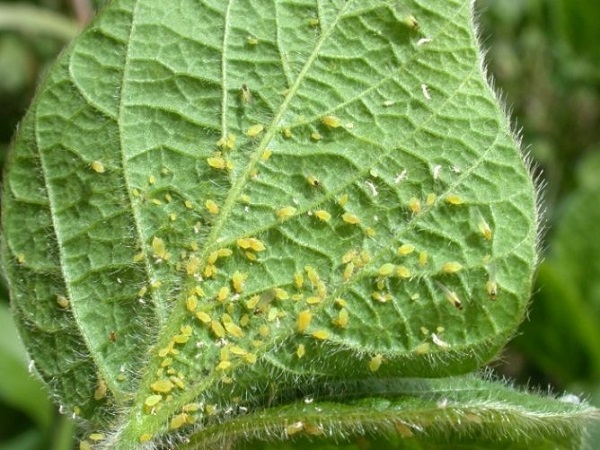
Aphids on cucumber leaves
How to get rid of the invasion of ants
Black ants are a useful insect, however they can become real enemies for cucumbers and tomatoes. If ants are found, it is recommended to place traps (containers with a sweet composition). It is important to destroy the nests so that the population migrates to another part of the garden. This can be done by simply loosening the soil or watering boiling water. Effectively sprinkle the beds with wood ash or crushed lime.
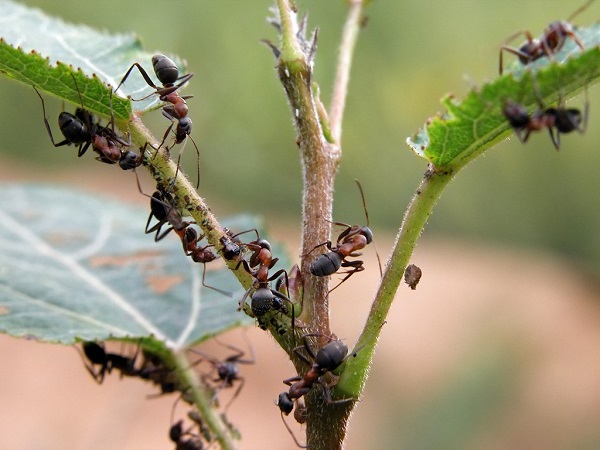
How to treat seedlings from spider mites
Another lover to feast on the sap of the plant is the spider mite. It is attached to the bottom of the sheet and covered with cobwebs. As the cucumber juice is exhausted, the leaf changes color, becomes marble, then turns brown and falls. The insect spreads on the beds in the greenhouse quickly, so you need to act instantly.
Methods of prevention and control:
- regular inspection of plants and maintaining the necessary moisture by spraying;
- timely destruction of weeds;
- treatment of plants with special preparations Aktellik, Fitoverm.
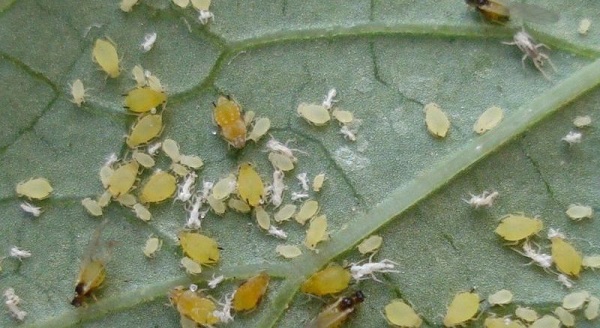
Popular way to deal with the whitefly
Insects are particularly dangerous for greenhouse crops, but there are frequent cases of damage to cucumber beds in open ground. Small parasites (about 1 mm long) have white wings and gray legs. The main diet is plant sap. In one bush there are insects in different stages of development, which complicates the fight against them.
Among the effective ways to fight:
- setting traps;
- proper care;
- soil loosening and weeding.
It is better to plant tobacco cucumbers near the cucumbers, which also attract the whitefly. They already can be processed by chemical means.
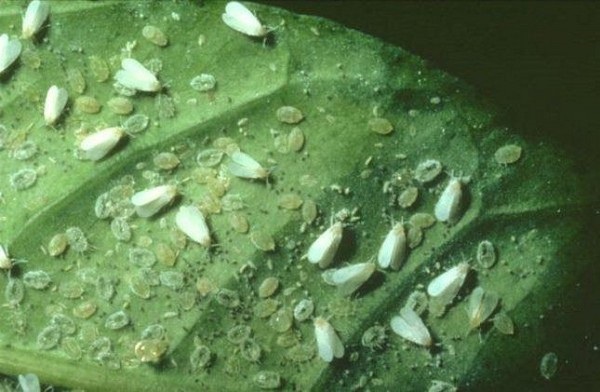
Sprout fly
Laid eggs in plant debris successfully survive the winter and begin to actively develop in early May - during the period of growth of seedlings. The fly causes great damage to germinating seeds and young shoots. The insect attracts the stem of the plant, where the females pupate. This period lasts about 2 weeks. During this time, the pest feeds on the sap of the plant, which leads to exhaustion and death of the seedling.
Prevention will help solve the problem, which includes autumn harvesting of beds and digging of soil. In the spring before sowing, the soil is decontaminated (watering with boiling water, spraying with a solution of potassium permanganate).
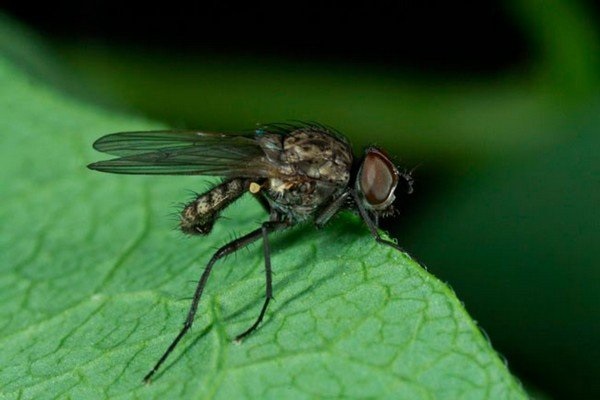
Gallic nematode
Small parasites reach a length of only 1.5 mm, live in whole colonies. In the warm season, the female lays up to 2000 eggs, which leads to an intensive growth of the population. Favorable habitat is considered hot weather and low humidity. Pests attack the root system, which subsequently weakens and even dies.
To combat the nematode, it is necessary to do prevention:
- disinfection of soil and inventory after autumn and spring processing;
- annual change of landing site;
- plentiful watering of the soil with boiling water with the subsequent covering of the site with a film for 2-3 hours;
- processing of beds by Fitoverm.
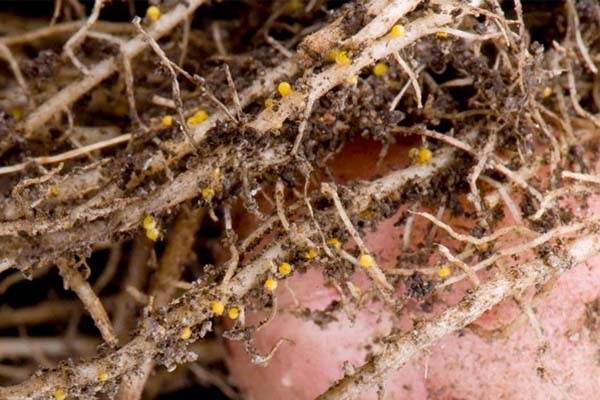
Slugs
In appearance, the slow-moving insects have a wonderful appetite. In the course goes not only greens, but also the skin of the fruit. Ugly fruits will only throw. Pests are allowed to detect themselves in silver tracks on the foliage and the characteristic holes.
Methods of prevention and control:
- Digging the earth in autumn and spring;
- mechanical assembly of slugs;
- cleaning plant waste and garbage;
- the use of molluscicides (for example, the drug Thunderstorm).
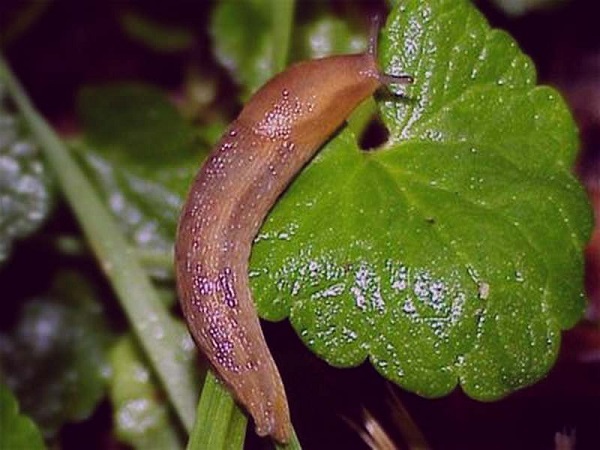
Medvedki
Cucumbers love a moist environment that attracts Medvedka. Quite large insects can eat up the roots and cause irreparable damage to the crop. It is possible to recognize a pest by characteristic burrows in the area and eaten up roots, stems and even fruits.
Of the existing methods of struggle, most gardeners prefer mechanical and folk methods. Special traps are made up along the contour of the beds, from which insects are periodically extracted. As bait are used: manure, beer, humus. It is also effective to fill the holes with soapy water. After the appearance on the surface of pests produce their collection and subsequent destruction.
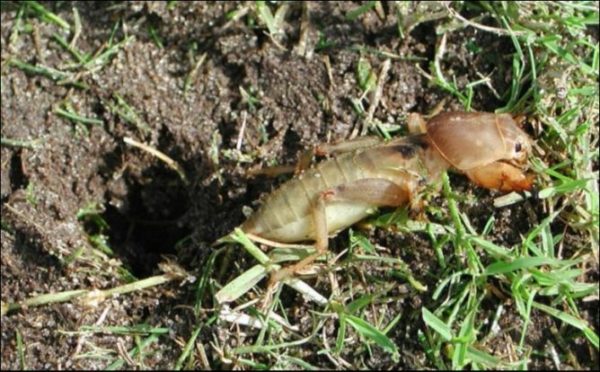
How to spray shoots against thrips
Insects sucking juice reach sizes of only 1.5-2 mm. Pests can be detected by the traces of their vital activity: silvery strokes on sheets, discolored areas on greenery, necrosis, deformations of different nature, sticky traces. Due to damage to the ovaries, the fruit forms an irregular shape. In addition, insects carry infectious diseases.
Methods of prevention and control:
- timely weeding and inspection of bushes;
- installation of sticky traps (better than blue);
- treatment of plants with infusion of garlic (per 10 liters of water 40-60 g of the aromatic ingredient, previously crushed);
- spraying with insecticides (the solution is prepared from 5 liters of water and 4 g of the drug).
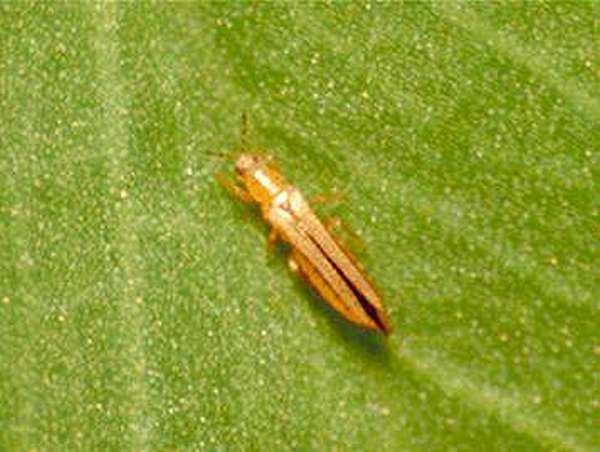
Cucumber mosquitoes
It is not immediately possible to detect parasites due to their grayish tint, which merges with the soil, and small sizes - 3-5 mm. Females lay eggs directly on the ground surface near the cucumber beds. Translucent developing larvae, reaching a length of 5 mm, easily move to the stems and roots from which they receive food. The victim of parasites are often weak shoots.
Methods of prevention and control:
- after harvesting, carefully remove plant residues from the site;
- before sowing, disinfect the soil with a weak solution of potassium permanganate or other means;
- a few days before the start of planting, process the soil with Aktellik (1-2 liters of mortar per 10 m2);
- provide proper care to strengthen the immune system.
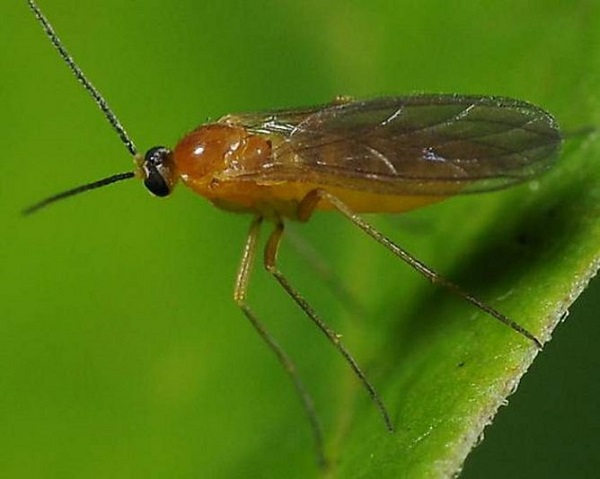
Protection of the roots from the wire
Externally, the wireworm is very similar to a worm, in fact, the pest is a two-year old larva of the click beetle. It is almost omnivorous, therefore it causes a lot of hassle to gardeners, damaging carrots, tomatoes, potatoes, cucumbers and other crops.It is actively developing in the soil, easily finding food: root system, roots, seeds.
At the end of the season, you should dig up the ground just before the frosts, so that the larvae and adults would freeze out during the winter. When servicing the beds, it is necessary to collect the identified larvae or beetles manually. Mechanical destruction of them is unlikely to happen because of the hard skin, so many gardeners drown collected pests in diesel or kerosene.
It is important to monitor the acid level of the soil. The acidic environment attracts the wireworm; therefore, if necessary, the soil is neutralized with dolomite flour, minced egg shells or wood ash. Additional protection will be planting around the perimeter of the bed of legumes that scare the parasite.

Preparations for the treatment of seedlings and land in the greenhouse from pests
Even before the beginning of the sowing period, it is worthwhile to consider preventive measures that will protect the beds from the invasion of insects, and in case of detection of a pest, respond with quick treatment. Proper prevention consists of the following points.
- For sowing, use only high quality material that has undergone disinfection and preparation.
- The soil for sowing seedlings and sowing seeds must also undergo a decontamination procedure so that harmful microorganisms do not switch to young shoots.
- Insects choose their habitat more often on weakened bushes, therefore, proper care should be taken of the seedlings so that their life potential helps to withstand the diseases and attacks of pests.
- When cleaning the site at the end of the season, all plant residues are removed from the ground. It is on them that the pathogens can remain, which, after hibernation, awaken for active development.
- Weeds can attract insects. In addition to interfering with the root system of cucumbers, weeds thicken the beds. And such a thicket is a good shelter for spider mites, onion flies, etc.
- A good prevention is considered to be changing the place of sowing cucumbers.
- Plants planted in the immediate vicinity of the cucumber beds (calendula, marigold flowers, radishes, etc.) can repel pests.

In order to quickly respond to the problem that has arisen, it is necessary to conduct regular inspection of the beds in order to identify lesions. Signs of habitat on cucumbers, insects or larvae are not considered a verdict, they can and should be dealt with. But it is better to do with preventive measures, which significantly reduce the risks of yield reduction or its complete destruction.
